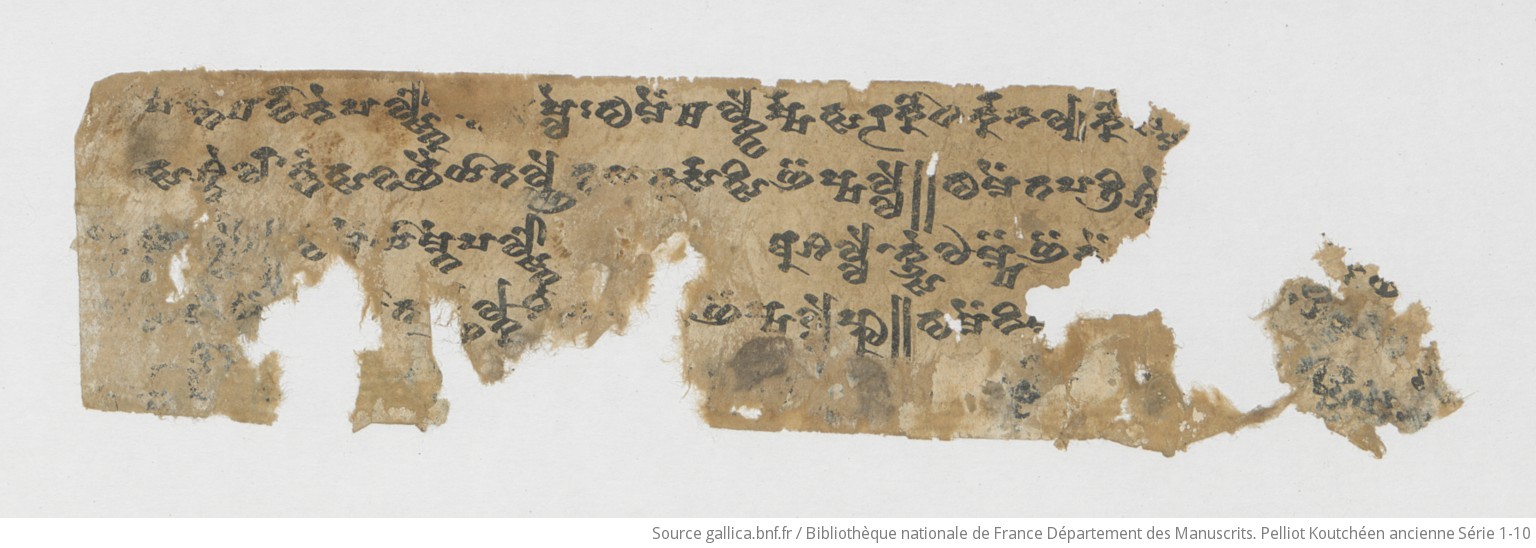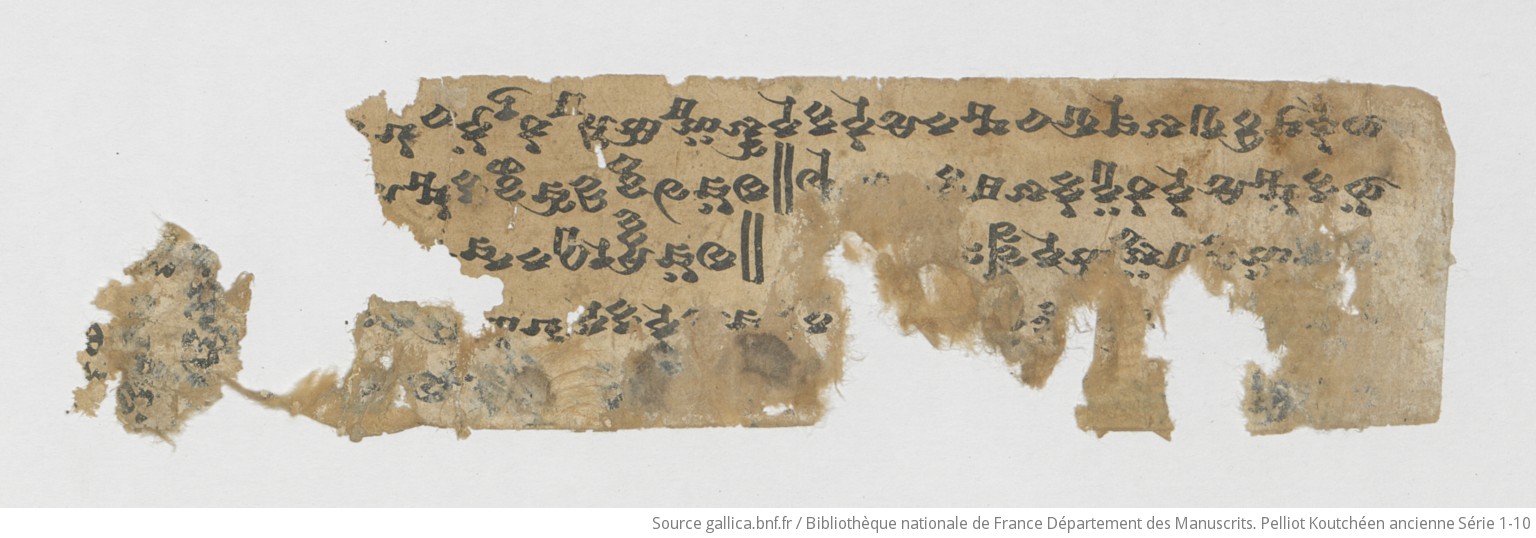Work in progress
PK AS 19.5
| Known as: | PK AS 19.5; Pelliot Koutchéen Ancienne Série 19.6 (number in 1982) |
|---|
| Cite this page as: | Georges-Jean Pinault; Hannes A. Fellner (collaborator). "PK AS 19.5". In A Comprehensive Edition of Tocharian Manuscripts (CEToM). Created and maintained by Melanie Malzahn, Martin Braun, Hannes A. Fellner, and Bernhard Koller. https://cetom.univie.ac.at/?m-pkas195 (accessed 05 Jul. 2025). |
|---|
Edition |
| Editor: | Georges-Jean Pinault; Hannes A. Fellner (collaborator) |
|---|
| Date of online publication: | 2014-07 |
|---|
Provenience |
| Expedition code: | M 504.5 (provisional number 1397) |
|---|
| Collection: | Bibliothèque nationale de France, fonds Pelliot Koutchéen (Paris) |
|---|
Language and Script |
| Language: | TB |
|---|
| Linguistic stage: | classical |
|---|
| Script: | classical |
|---|
Text contents |
| Title of the work: | Pratītyasamutpāda |
|---|
| Text genre: | Literary |
|---|
| Text subgenre: | Abhidharma |
|---|
| Verse/Prose: | prose |
|---|
Object |
| Manuscript: | PK AS 19 |
|---|
| Material: |
ink
on paper |
|---|
| Form: | Poṭhī |
|---|
| Size (h × w): | 6.5 × 21.2 cm |
|---|
| Number of lines: | 5 |
|---|
| Interline spacing: | 1.2 cm |
|---|
Images
Transliteration
| a1 | pi ṅte pa rwā ne pa lsko [st]· – ṣle : tu meṃ ma lkwe rṣṣa tsa ra ko ta rka na lya k[au] ss· /// |
|---|
| a2 | tsa śt[w]e rlā ntaṃ tsa wa rñai yā ta lñe nta sa ka rsa tsi ñä ṣṣa lle || tu meṃ ta pa tri śne /// |
|---|
| a3 | – – || [tu] meṃ yā mne pa lsko ○ a śa lle • kuse o¯ ¯mpä ñä [k]teṃ – – – k· /// |
|---|
| a4 | – wa [r]ñ[ai] [ñä] – e – [yā] ta [l]ñ· lkā t(·)i – (– –) ñä ṣṣa lle 4 || tu meṃ ni· m· – – – – – yā /// |
|---|
| a5 | /// |
|---|
| b1 | /// tu – – /// |
|---|
| b2 | – – – – – – – i [me] – – (–) ta – m· [ña] ke nta kā rp· ye· [ñ]ī /// |
|---|
| b3 | [kā] – yeṃ [tū] pa¯ ¯stä y[o] ka lle 2 ○ || tu meṃ śtwā ra dhya na nma /// |
|---|
| b4 | ñeṃ nta ṣṣe śū ke ce kyä kne sa ma kt· – ·[t]· 5 || tu meṃ o¯ ¯kt wi mo ks̝a nta ṣṣe [ś]· /// |
|---|
| b5 | ña ke pra tī tya sa mu tpā ta ṣṣa na śū ke nta ka rso¯ ¯ymä yo śi¯ ¯m ce¯ ¯u kreṃ¯ ¯t pe [l]· /// |
|---|
Transcription
Translation
| a1 | ... in between the mind should be put on the eyebrows. Thereupon a gush of milk ought to be released in order to be poured ... |
|---|
| a2 | ... one should desire the understanding through the capacities beginning with the four kings. |
|---|
| a2+ | Thereupon (in the realm) of the thirty-three gods ... |
|---|
| a3 | ... Thereupon the mind should be lead to ... |
|---|
| a3+ | Who there ... the gods ... |
|---|
| a4 | ... one should desire the (sight?) to see the capacity of the gods beginning with ... Thereupon ... illusory (?) ... |
|---|
| b2 | ... may now the ... not at all descend into my (mind?) ... |
|---|
| b3 | ... may ... descend (into my palm), that ought to be drunk up. Thereupon the four meditations ... |
|---|
| b4 | ... the nectar consisting of the virtuous (?) is the goal of that sort indeed. Thereupon the nectar consisting of the eight salvations (vimokṣa-) ... |
|---|
| b5 | ... now I may understand the nectars of the pratītyasamutpāda. May I drink this (nectar) consisting of the good La(w) ... |
|---|
Commentary
Remarks
| * | The fragments of the PK AS 19 series (19.1-19.22) all belong to the same manuscript. The recto and verso cannot be determined with full certainty. On the left margin of one side there is a trace that rather belongs to the imprint of another leaf than being a leaf number. Furthermore, this trace does not exhibit the characteristics of a number. On the other side there are faint traces of a leaf number. The fragment is the left half of a leaf comprising the string hole. The string hole interrupts the third line. On the right end a small piece of another leaf has accidentally been joined to the manuscript. |
|---|
Linguistic commentary
| n1 | The form kaussi is the infinitive of the Kausativ of the verb ku- 'to pour'. This line falsifies the meaning 'weapon' for the word tsarako as given by Adams 2013: 730. |
|---|
| n2 | The form yāmne looks as the locative singular of a noun yām which is so far unknown. This interpretation seems more likely than assuming an oblique dual. In any case the reading 〈yā〉 is safe by contrast with the alternative reading 〈yo〉. We may mention the possibility of interpreting yām* as the root noun of the root yām- 'to do, to make' meaning something like 'doing, action'. |
|---|
Philological commentary
| n3 | We propose to restore the plural of the abstract kärtsauñe as the basis of the following ṣṣe-adjective, but it remains to be confirmed by a parallel text. |
|---|
| n4 | Apparently there seems to be an anusvara upon 〈ṣṣe〉, but it would be at variance with the syntax since this adjective is to be constructed with śūke. Therefore it is more likely that this is a stain on the leaf. In addition, It does not comply with the usual form of the anusvara in this ductus. |
|---|
Bibliography
Adams 2013
Adams, Douglas Q. 2013. “More thoughts on Tocharian B prosody.” Tocharian and Indo-European Studies 14: 3–30.




